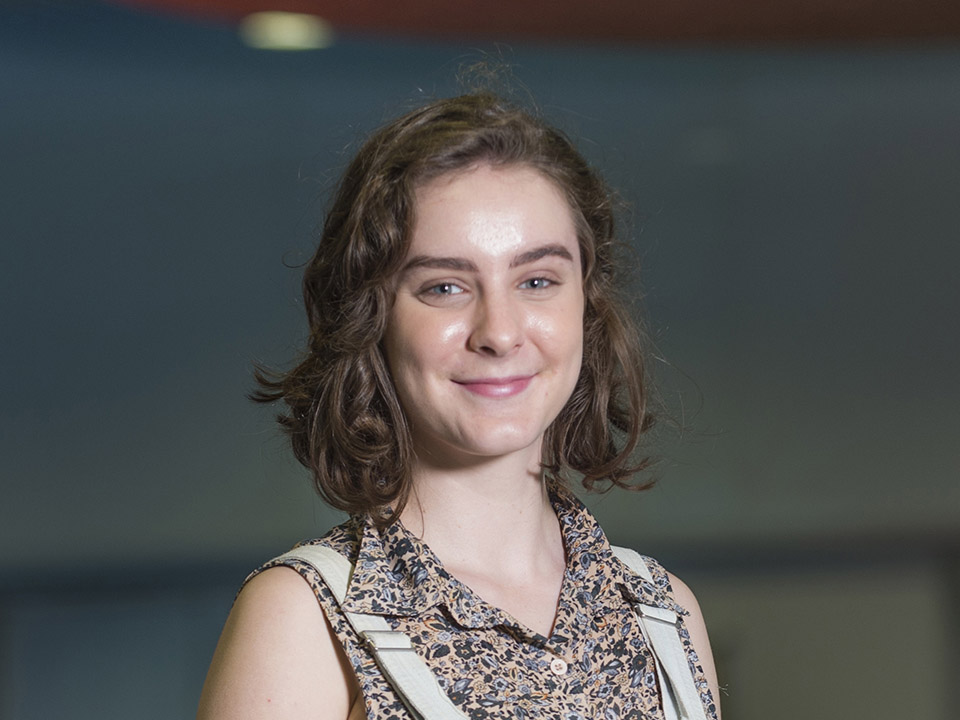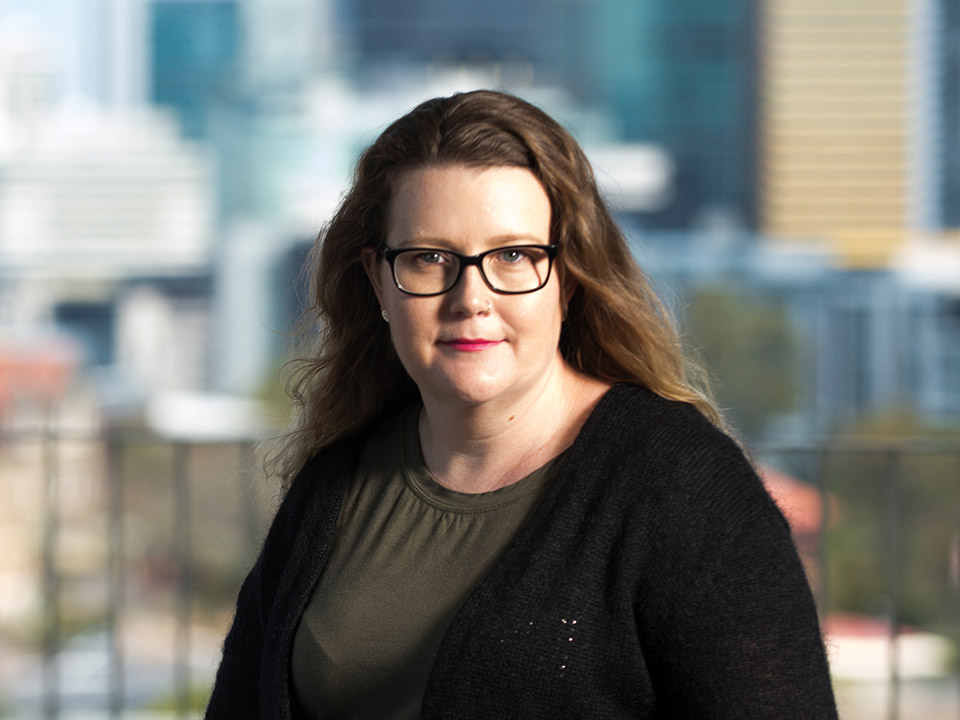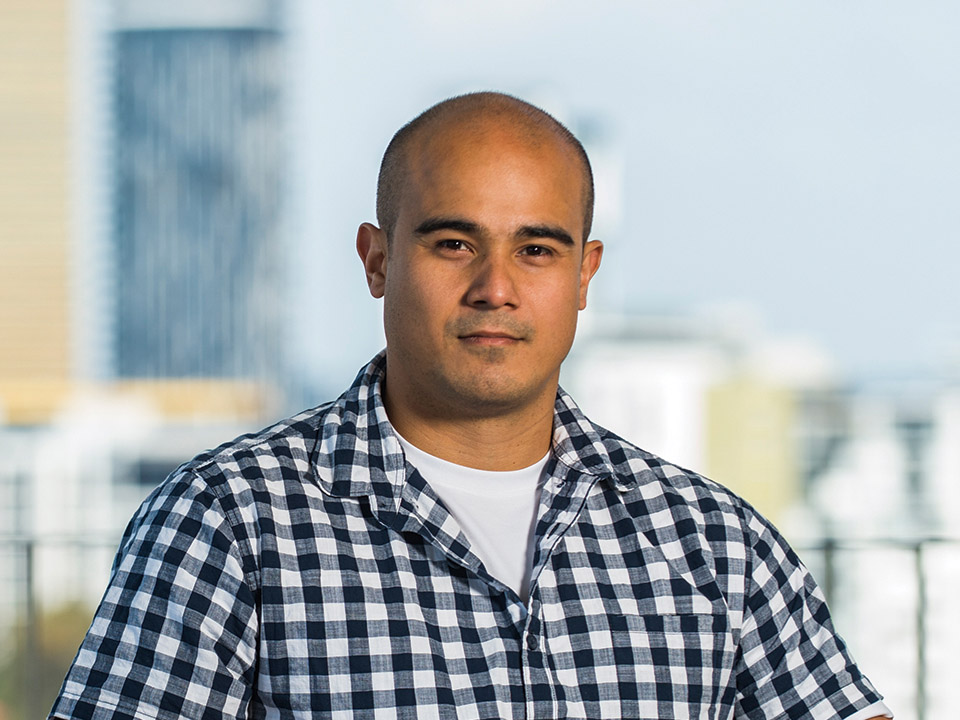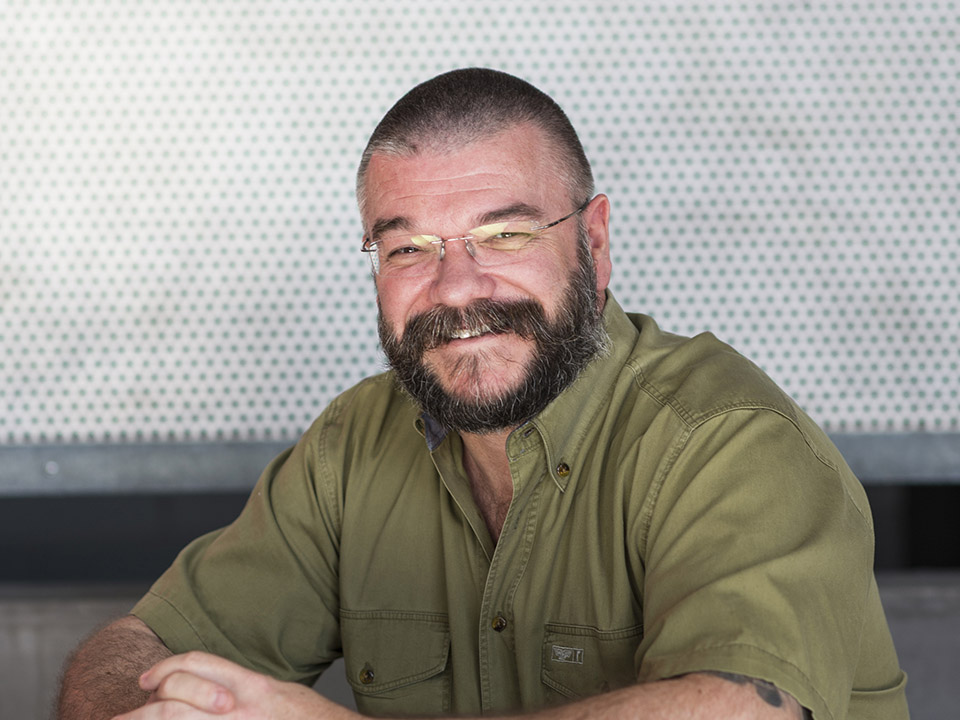A career helping people
‘Paramedic science is great choice for people who thrive in fast-paced and unpredictable environments. On placement I worked alongside the High Acuity Response Unit, which are the Queensland Ambulance Service’s elite paramedics who go to major traumas. They were using ultrasounds on a patient and explaining it to me. It’s exciting to see the level of diagnostic abilities that can be brought to pre-hospital care.’
World-class training facilities
The Clinical Simulation Centre is home to advanced simulation equipment that mirrors real workplace scenarios. Located at the Kelvin Grove campus, the centre is equipped with hospital wards and high-tech mannequins that mimic human responses such as sweating or yelling out when in pain.
Placements make the best practice
'Paramedic science offers multiple six-week placements and the option to travel overseas in your third year. Domestic placements serve as long job interviews and help you to build industry connections while working as part of an ambulance crew. It consolidates class learning and I gained experience with pre-hospital births, high-velocity trauma, and multi-system medical cases. I also travelled to the USA for a three-week placement and experienced ride-alongs with ambulance and fire services and even helicopter and fixed-wing flight care services.'
Real-world training
Paramedics work in diverse settings and often have to make quick decisions about patient care. If the owner of an assistance dog requires emergency help, a paramedic needs to understand the relationship between the dog and its owner. Representatives from Assistance Dogs Australia and Smart Pups visited QUT with their dogs so students could learn how to handle this complex situation.
Real experience working alongside professionals
As well as clinical placement on the road, paramedic students get first-hand experience working alongside other emergency service providers to treat casualties in simulated trauma scenarios.
A career helping people
‘Paramedic science is great choice for people who thrive in fast-paced and unpredictable environments. On placement I worked alongside the High Acuity Response Unit, which are the Queensland Ambulance Service’s elite paramedics who go to major traumas. They were using ultrasounds on a patient and explaining it to me. It’s exciting to see the level of diagnostic abilities that can be brought to pre-hospital care.’
Placements make the best practice
'Paramedic science offers multiple six-week placements and the option to travel overseas in your third year. Domestic placements serve as long job interviews and help you to build industry connections while working as part of an ambulance crew. It consolidates class learning and I gained experience with pre-hospital births, high-velocity trauma, and multi-system medical cases. I also travelled to the USA for a three-week placement and experienced ride-alongs with ambulance and fire services and even helicopter and fixed-wing flight care services.'
Real-world training
Paramedics work in diverse settings and often have to make quick decisions about patient care. If the owner of an assistance dog requires emergency help, a paramedic needs to understand the relationship between the dog and its owner. Representatives from Assistance Dogs Australia and Smart Pups visited QUT with their dogs so students could learn how to handle this complex situation.
Real experience working alongside professionals
As well as clinical placement on the road, paramedic students get first-hand experience working alongside other emergency service providers to treat casualties in simulated trauma scenarios.
Experience science in 360 degrees
When you study with us, you’ll be working in real clinical settings and simulation environments from your first year. Explore our 360° environments and see what real-world health sciences can mean for you.
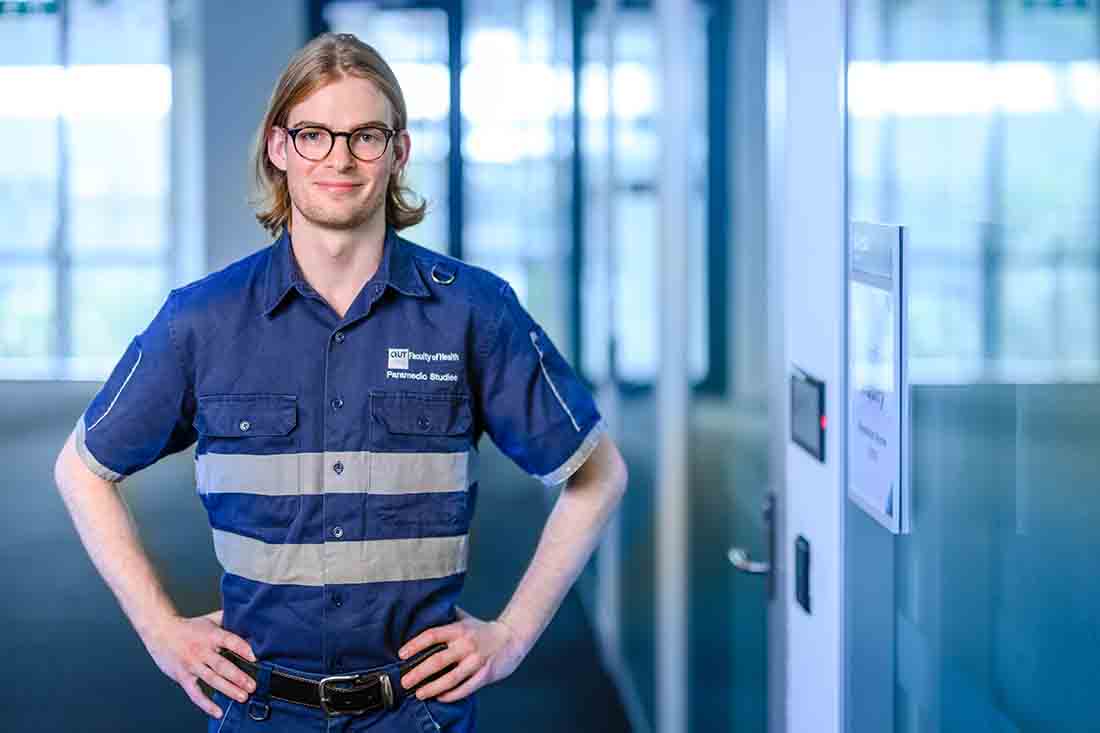
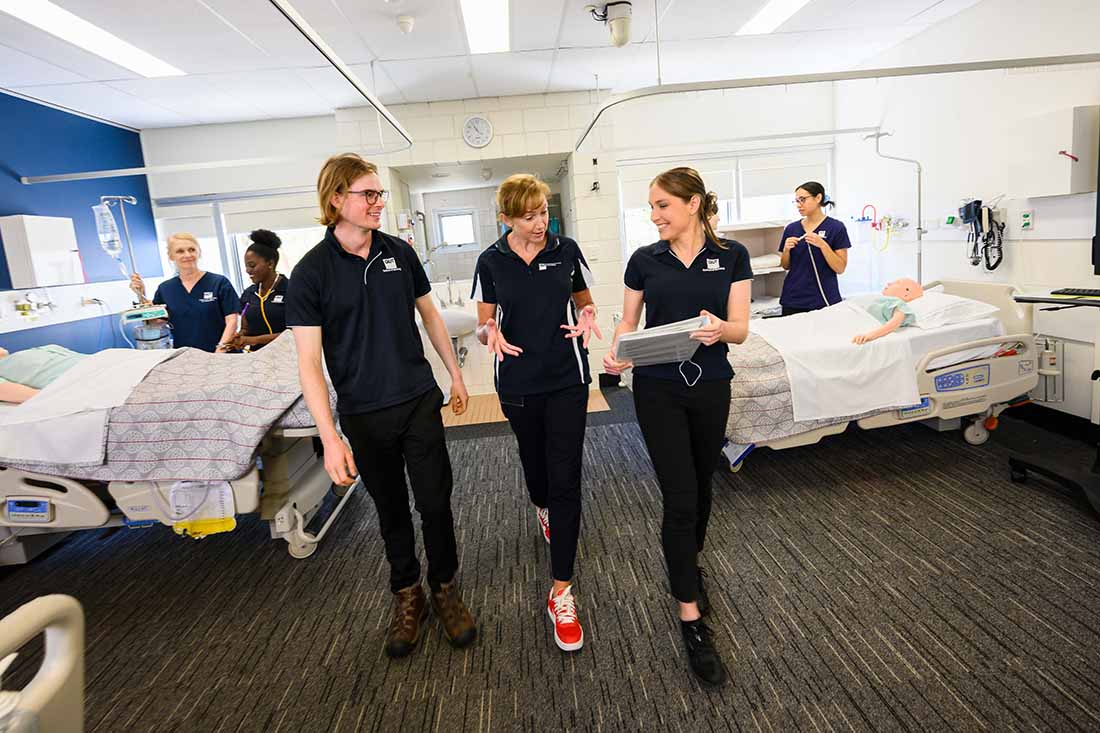
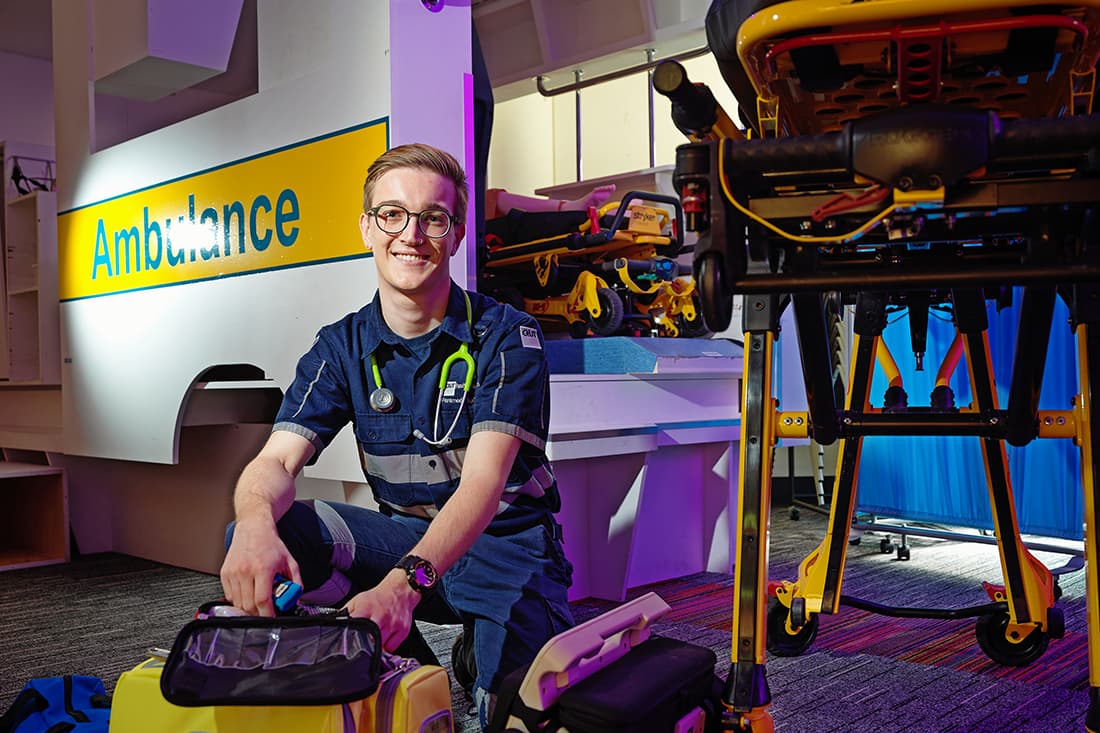
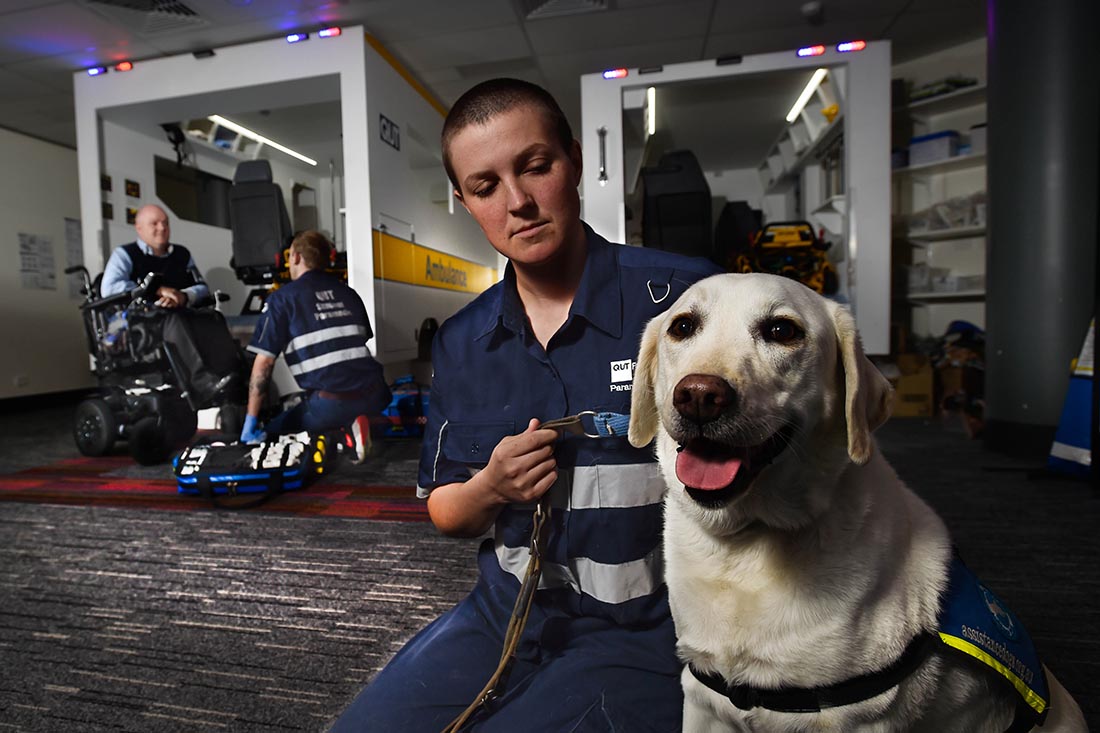
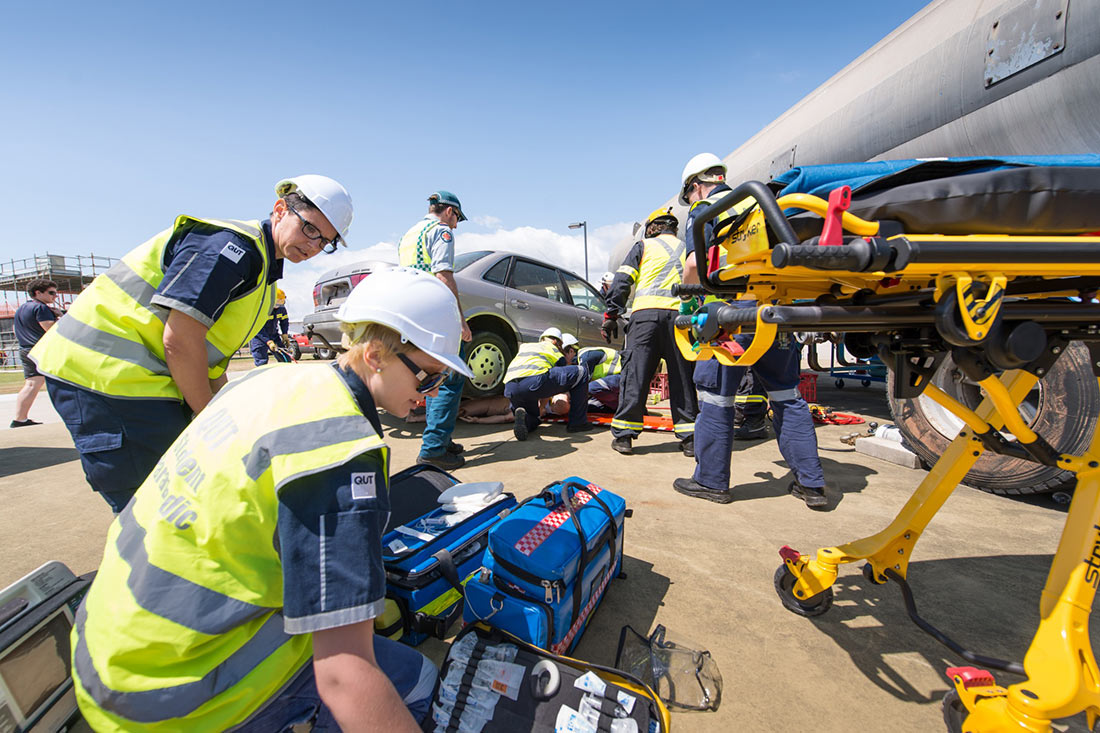




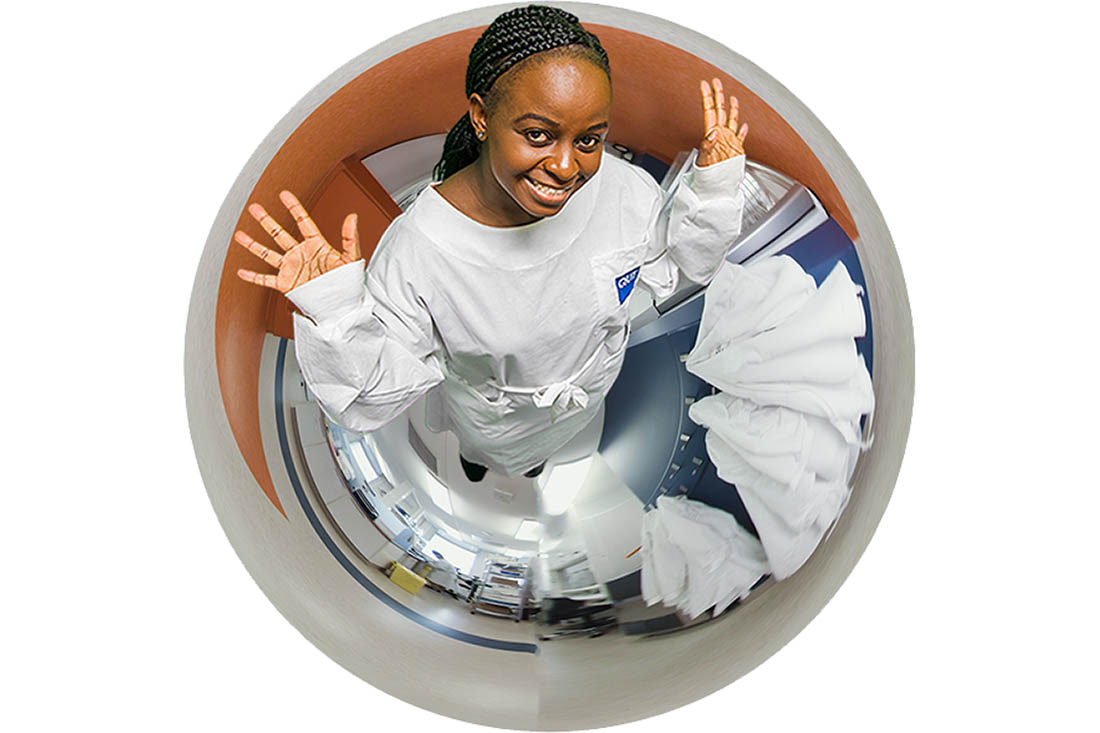
Highlights
- Gain extensive experience with Queensland Ambulance Service – first placement begins in first year.
- Study anatomy and physiology of the human body, pathology, pathophysiology, pharmacology and clinical practice.
- Participate in scenario-based training alongside other emergency service providers.
- For health graduates: consider the Bachelor of Paramedic Science – Graduate Entry.
Highlights
- Gain extensive experience with Queensland Ambulance Service – first placement begins in first year.
- Study anatomy and physiology of the human body, pathology, pathophysiology, pharmacology and clinical practice.
- Participate in scenario-based training alongside other emergency service providers.
- For health graduates: consider the Bachelor of Paramedic Science – Graduate Entry.
Why choose this course?
This course was Queensland’s first degree in paramedic science and our established partnerships ensure you will complete extensive placements with the Queensland Ambulance Service (QAS).
Our staff are experienced paramedics and allied health professionals and will give you first-hand knowledge of the profession through case studies and personal experiences.
On campus, you will learn in facilities that feature life-sized ambulance simulators, human patient simulators, and multi-casualty sites that imitate a building collapse, car accident or explosion. You will develop an appreciation of anatomical variability, pathology and effective medical communication with the opportunity to work with human donor material.
Real-world learning
Your first clinical placement begins at the end of your first year of study. We offer placements in metropolitan and regional centres throughout Queensland, as well as opportunities to travel overseas and work on shift with paramedics in other ambulance services. In recent years our students have travelled to China, the United Kingdom, Vanuatu and the United States.
Our students develop leadership skills and learn how to manage critical situations under pressure with scenario-based training alongside other emergency service providers, including the Queensland Fire and Emergency Service and the Australian Army.
Explore this course
Paramedics provide rapid, emergency medical response and specialised transportation to the community. Each day a paramedic may respond to a number of call outs— not all of which will be emergencies. A paramedic’s work also consists of non-life threatening cases, transporting elderly patients and patients who have scheduled hospital treatments.
Careers and outcomes
Graduates may be employed as an ambulance paramedic with the QAS, and national and international agencies. They may complete further study for a career as a critical care paramedic or for careers in health service management, public health, or emergency and disaster management.
Professional recognition
This course is currently approved by the Paramedicine Board of Australia. Graduates are eligible to apply for registration with the Paramedicine Board of Australia and for membership with Paramedics Australasia.
Possible careers
- Paramedic
- ATAR/selection rank threshold
- 87.00
These thresholds are the lowest adjusted scores to which QUT made an offer in Semester 1, 2024.
Don't have a ATAR/selection rank?
- Course code
- CS43
- QTAC code
- 425592
- CRICOS code
- 0101676
-
- Kelvin Grove
- 3 years full-time
- February
Assumed knowledge
Before you start this course, we assume you have sound knowledge of the subject/s listed below. If you don't have the subject knowledge, you can still apply for the course but we strongly encourage you to undertake bridging studies to gain the knowledge:
- English, or Literature, or English and Literature Extension, or English as an Additional Language (Units 3 & 4, C)
Offer guarantee
From 2022 this course will no longer be covered by the offer guarantee. The course threshold can be used as a guide for the ATAR/selection rank you may need to get into a course in the future. Thresholds can change from year to year.
Advanced standing
If you have prior studies or work experience, you may be eligible for advanced standing (credit). You can apply for advanced standing once you've been accepted to QUT. If you're in your first semester of study, you must apply for advanced standing within 10 days of receiving your offer.
Deferment
You can defer your offer and postpone the start of your course for one year.
More about deferring your offer
Adjustments to your ATAR/selection rank
Any adjustments you receive to your ATAR or selection rank will be applied to this course.
Find out if you’re eligible for an adjustment to your ATAR or selection rank
Offers we made to school leavers in Semester 1, 2023
The figures listed in the tables below reflect the offers that were made to recent ATAR students. The entry thresholds box at the top of this page shows the lowest adjusted ATAR/selection rank required to receive an offer for all applicants for the most recent January QTAC offer round.
| Excluding adjustments | Including adjustments | |
|---|---|---|
| Highest ATAR/selection rank to receive an offer |
Selection rank
97.80
|
Selection rank
99.95
|
| Median ATAR/selection rank to receive an offer |
Selection rank
89.75
|
Selection rank
92.20
|
| Lowest ATAR/selection rank to receive an offer |
Selection rank
78.00
|
Selection rank
87.00
|
You can find out more about your fellow students’ backgrounds with this course’s student profile.
Other admission options
If you are of Aboriginal or Torres Strait Islander descent, you may be eligible for admission through our Centralised Assessment Selection Process (CASP).
I completed secondary school in Australia
- ATAR/selection rank
- 87.00
Minimum English language requirements
Don't have the English language score you need? We can help!
We offer English language programs to improve your English and help you gain entry to this course.
When you apply for this course, we will recommend which English course you should enrol in.
Course requirements
There are extra costs and requirements for this course including a blue card, vaccinations and placement uniforms. There are also standards regarding behavioural stability as well as mandatory requirements (medical and mental health fitness assessment) that are inherent expectations for clinical placement and to complete this degree.
Blue card: You must undergo a criminal history check for working with children and be issued with a suitability card (blue card) before commencing clinical placement/practicum in an organisation where they may work with children or young people.
The processing of your application may take several months so you must submit your blue card application to HiQ as early as possible to ensure you have your card before you begin any unit that requires contact with children. There is no charge for student blue cards. Students who already have a blue card must register it with QUT.
Information is available from the Additional course requirements and costs website.
International student entry
This course is not available for entry to international students.
Your actual fees may vary depending on which units you choose. We review fees annually, and they may be subject to increases.
2025 fees
2025: CSP fees available from September
Additional Costs
There are requirements that you will need to meet as a student in this course. Some of these requirements have associated costs. Information is available from the Additional course requirements and costs website.
2025 fees
2025: Available from July
Additional Costs
There are requirements that you will need to meet as a student in this course. Some of these requirements have associated costs. Information is available from the Additional course requirements and costs website.
2024 fees
2024: CSP $9,000 per year full-time (96 credit points)
Additional Costs
There are requirements that you will need to meet as a student in this course. Some of these requirements have associated costs. Information is available from the Additional course requirements and costs website.
2024 fees
2024: $38,700 per year full-time (96 credit points)
Additional Costs
There are requirements that you will need to meet as a student in this course. Some of these requirements have associated costs. Information is available from the Additional course requirements and costs website.
Student services and amenities fees
You may need to pay student services and amenities (SA) fees as part of your course costs.
HECS-HELP: loans to help you pay for your course fees
You may not have to pay anything upfront if you're eligible for a HECS-HELP loan.
You can apply for scholarships to help you with study and living costs.
QUT Excellence Scholarship (Academic)
QUT's premier offering for students with outstanding academic achievement.
- Scholarship eligibility
- Academic performance
Keep up to date
QUT courses for you
Like to save your courses?
Please enter your first name and email so we can save your courses for you
